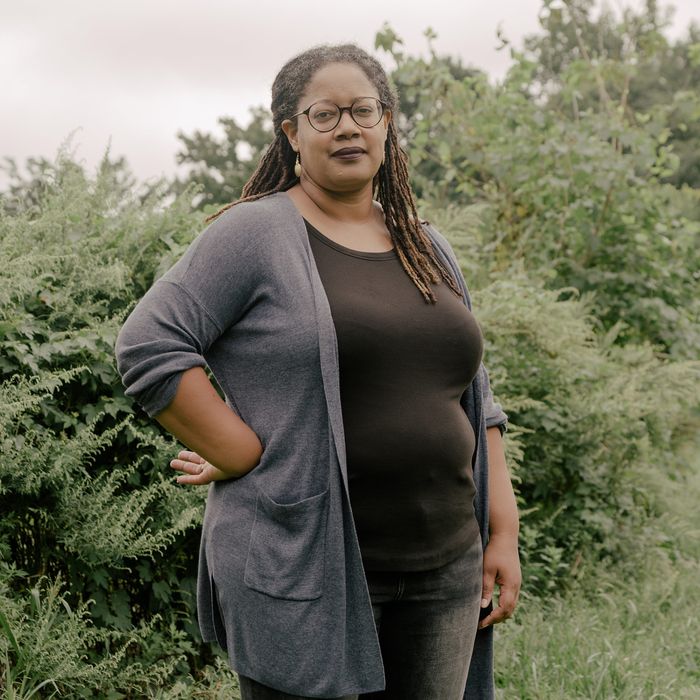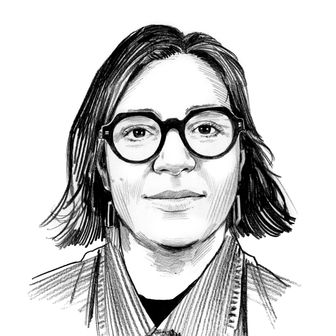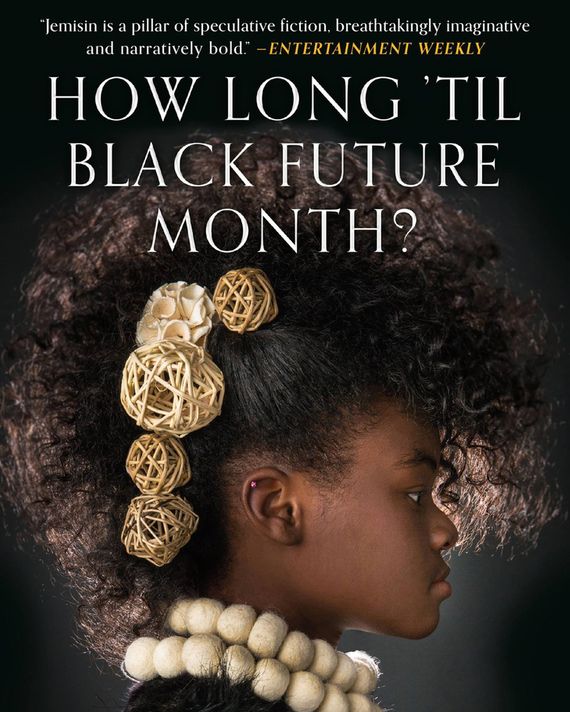
At the very northern tip of Manhattan lies one of the last wild places in New York City, a swath of ancient forest that has survived more or less undisturbed for hundreds of years. On an overcast afternoon, the park is relatively quiet, save for the occasional squawk of migrating geese and the distant groan of the Metro-North winding up the Hudson. A solitary jogger lopes along a dirt path edging the dense woods. “I love this park because it’s the last of the forest as it used to be, before we showed up and fucked up everybody’s shit,” fantasy writer N.K. Jemisin tells me as we set off through the woods, her hands tucked pensively into the pockets of a long gray cardigan. After a moment, she adds an important caveat. “Well, I mean, technically my ancestors weren’t fucking anybody up. They were just being fucked up. That said … ” She drifts off, her eyes on the red oaks overhead. Reality always creeps into Jemisin’s fantasies, whether she wants it to or not.
We’re here on a research expedition to gather details for a scene in her new trilogy, which she describes as a magical battle for the soul of New York City. Over the last decade, Jemisin, a former practicing psychologist, has become one of the world’s most acclaimed authors of science fiction and fantasy, known for crafting richly imagined fantastical realms and melding elements like mysterious sentient floating crystals with searing critiques of contemporary political power structures. For her new book, she wanted to write something light and fun — “a palate cleanser” about tentacled monsters — but Jemisin can never stay away from heavy themes for long. Partway through her first draft, it dawned on her that the new book was really about gentrification and racism. “I just want to write about things blowing up. Gods and planets and moons crashing into things,” she tells me. “But what I write ends up being very political. If I write about dragons, I’m writing about dragons as a black woman, and it’s fucking political.”
Part of why Jemisin is viewed as “political” is the mere fact that she writes about things like dragons and planets at all. Since at least the early 1900s, when people began using “fantasy” to signify a certain type of literature, the genre has been dominated by white male authors and their nostalgia for the pastoral European past, a time of kings and queens and wizards, all of them white. The heroes in these tales are often intent on saving that traditional order from some alien force — an invading army of orcs, an evil sorcerer. Jemisin flips that formula on its head. The Broken Earth, her latest and most famous trilogy, begins with an oppressed man, an escaped slave of sorts, setting off an earthquake that rips the land in two, toppling cities and covering the realm in a cloud of ash that will linger for thousands of years. In Jemisin’s telling, this isn’t necessarily a bad thing. As one character tells another, “Some worlds are built on a fault line of pain, held up by nightmares. Don’t lament when those worlds fall. Rage that they were built doomed in the first place.”
Jemisin’s phenomenal success has been something like an earthquake ripping through the traditional order of fantasy itself. (Perhaps this explains why certain writers, nearly all of them white men, have taken issue with her rise. But more on that later.) All together, her work has sold a million copies in English and has been translated into 24 languages; TNT is developing it as a TV show. In 2016, the opening book in the trilogy won the Hugo Award for best novel, science fiction and fantasy’s most prestigious honor. She was the first black writer to win this award, though she doesn’t see this as a milestone worth celebrating. “It just emphasizes how flawed the field has always been,” she says. The following year, she won the Hugo again. This year’s win made her the first writer of any race to claim the award three years in a row for each book in a trilogy. For perspective, George R.R. Martin has been nominated in that category four times, but has never won; Neil Gaiman, a fan of Jemisin’s and one of fantasy’s most bankable stars, has won only twice. The demands of success have not disrupted her torrid writing pace; when she’s on deadline, Jemisin aims for 3,000 words a day, and has managed to publish ten books in just the past eight years. Her latest, How Long ‘til Black Future Month?, out this week, is a collection of short stories, her first book to be released in hardback.
Jemisin, born Nora Keita, is 46 years old, tall and poised, with a piercing gaze and faint dimples when she smiles. In the park, she’s wearing black jeans and sneakers, round tortoiseshell glasses, and a ring made of amethyst and citrine. (She is “easily distracted by shiny things,” which perhaps explains why her books include so many lush descriptions of crystals.) Her sense of humor is very dry. As we step out from beneath the canopy of trees into a wide arc of overgrown grass, her lips, stained blackberry, curve into a wry smile. “Yay,” she deadpans, pointing to a boulder in the distance. “It’s a rock.” This rock is why we’ve made the two-hour journey up from Brooklyn. It’s the site of a scene in her next trilogy, the first installment of which is due out next fall. Jemisin, currently working on a draft, is here to take notes and block out the action.
For a fantasist, Jemisin’s books feel unusually grounded. The magic in The Broken Earth is called orogeny, which is a real geologic process that causes mountains to form. “She’s a realist,” says rapper and actor Daveed Diggs, an executive producer on the TV adaptation of The Fifth Season (and a fan who name-drops Jemisin’s characters in his music). On the Stillness, the land where The Broken Earth is set, those who wield orogeny can raise mountains by reaching, with their minds, into the molten magma of the earth; for their talents, they are subjugated by a society that needs and fears them in equal measure. “The idea that there’s a certain kind of magic embedded in a race of people that is ultimately to be feared or worshiped or commodified is woven into our times,” says Diggs.
Jemisin draws even more heavily on psychology and sociology than on the hard sciences. In a seminar on world-building that she occasionally gives at writing conferences, she encourages aspiring writers to read classic works on the history of human civilization, like Jared Diamond’s Guns, Germs, and Steel. She also recommends doing field research. For The Broken Earth trilogy, she went on a volcano tour of Hawaii. She wanted to touch the ash and inhale the stench of sulphur and ask people how it felt to live in a place that is perpetually in danger of blowing up. “I’ve always written the kind of thing that would entertain me. And the kind of thing that entertains me is something that acknowledges the reality of the world,” she says. “And the reality of the world that we all live in is that human beings do horrible things to each other, and beautiful things to each other.”
The boulder that we’re staring at right now is a monument to the mythical origins of the beautiful, horrible city that is New York. “That’s the spot where — supposedly — 400 years ago, Native Americans sold New York for 26 bucks,” she explains. An ancient tulip tree once grew there, she adds, “before pollution killed it.” The rock itself isn’t much to look at. It’s neither particularly big nor oddly shaped. “It’s not a very interesting landmark,” she acknowledges. But it’s important to her book, she says, because of its symbolic weight. She sees the story of that land grab as the Ur-myth of gentrification — a fantasy of white domination through the familiar tactics of real-estate speculation. And with her new book, she intends to blow that myth to pieces.
At the Hugo Award ceremony this past August, Jemisin delivered an acceptance speech that encapsulated much of what makes her one of the most exciting and relevant fantasy writers of the moment. Wrapped in a regal cape embroidered with shimmering stars and moons, she spoke about the layers of realism behind The Broken Earth. The trilogy was not only a commentary on the history of structural oppression and contemporary race politics, she said, but also a critique of fantasy and science-fiction culture itself.
She was speaking from a place of personal experience. “I have smiled and nodded while well-meaning magazine editors advised me to tone down my allegories and anger. I didn’t,” she said. “I have kept writing even though my first novel, The Killing Moon, was initially rejected on the assumption that only black people would ever possibly want to read the work of a black writer. I have raised my voice to talk back over fellow panelists who tried to talk over me about my own damn life.” Calling out the “mediocre insecure wannabes” who suggested that her victories were based on identity politics, not merit, she held up the award trophy, a gleaming statue of a rocket ship from a 1950s sci-fi movie. “This is the year I get to smile at those people,” she said, “and lift a massive, shining, rocket-shaped middle finger in their direction.”
The speech was the culmination of a conflicted relationship with the genre that began four decades ago, in her hometown of Mobile, Alabama. “I grew up at the library,” she says. When her mother was busy, instead of hiring a babysitter, she’d drop Jemisin off at the library. She spent her summers in New York City with her father, a painter and sculptor who introduced her to Star Trek and The Twilight Zone. Her cousin, comedian W. Kamau Bell, who hosts CNN’s United Shades of America, says that even as a kid, Jemisin was a diligent writer. (Then, as now, she tended toward dark fairy tales and apocalyptic adventures.) When the family gathered at their grandmother’s clapboard house in Mobile, Jemisin and Bell would sneak away to a secluded hallway to sprawl out on the floor, writing and drawing. (Back then, Bell wanted to be a comic-book artist.) “We were both only children, and we owned our only-childness in a profound way. We were able to keep our own company in ways that other people can’t,” Bell says. “There was this sense that we never fit in. Not that we didn’t love our family, but it was a big, loud family, and when Nora and I were together, most of the time we were so quiet.”
As much as she loved fantasy and science fiction, Jemisin felt like a misfit in those worlds, too. She read her first speculative book by a woman of color, Octavia Butler’s Dawn, in her late teens. Tellingly, she didn’t realize that Butler was black until a couple chapters in; the 1987 edition of Dawn was whitewashed to remove all references to blackness from the book’s packaging. (The cover depicted the black protagonist as a pale-skinned brunette, and Butler herself had no author photo.) Apart from Butler, “every single freaking thing I read was about a white dude doing white-dude things.” So, when she scribbled in her notebooks late at night, wrestling with her bouts of insomnia, Jemisin found herself writing about white dudes, too. “For the longest time, I would not write women. I would not write black women. I didn’t know how,” she says.
Jemisin was a dreamy kid, but she was practical, too. She didn’t think it was possible for a black woman to have a career as a fantasy writer. So when it came time for her to choose a profession, she followed the example of her mother, a psychologist who administered IQ tests. Jemisin studied psychology at Tulane and the University of Maryland and got a job as a career counselor specializing in what she describes as “at risk” populations — marginalized groups, first-generation students, older people having midlife crises. When she turned 30, she had her own crisis. Swimming in student debt, she decided to try to make a little side money from her lifelong hobby. “I thought, well I have this talent, I haven’t monetized it,” Jemisin recalls. “I don’t know if I can because I don’t think that the publishing marketplace is really interested in what I write, but if I can at least develop it to get a few hundred dollars a month, that will make a difference.”
Her first short story was published two years later, in 2004. The next year, an agent picked the manuscript of Jemisin’s first novel out of the slush pile. The agent, Lucienne Diver, was struck by the setting, a fantastical realm inspired by ancient Egypt, and by the characters, who were nearly all black. “I’ve been reading fantasy all my life, and so much sounds the same,” Diver tells me. “Nora’s book was not like anything else I’d ever read.”
Diver didn’t think that Jemisin’s books belonged in the African-American section at the library, so she sent the manuscript out widely to fantasy editors at all the major houses. But everyone passed. Jemisin says that some editors told her they thought the book was good, even groundbreaking, but they didn’t know if it would find an audience. “They thought the black readership wouldn’t be interested in fantasy, and the fantasy readership would not be interested in blackness,” Jemisin says. Diver, for her part, says it’s always difficult to know why a particular project doesn’t sell, but she acknowledged that if she were to go out with a book like The Killing Moon today, it would be a far easier pitch. These days, nearly everyone in the industry will tell you that publishing diverse voices is a top priority, but back in 2006, when Diver was shopping Jemisin’s first manuscript, “that was not even part of the conversation.”
Jemisin was heartbroken. Friends and family encouraged her to self-publish. She remembers a fellow black author telling her, “They don’t want us or anything we’re going to write, so you’re going to have to do it yourself.” She thought about quitting. Instead, she poured her anger and disappointment into her next book, The Hundred Thousand Kingdoms, about a world in which gods had been enslaved by humans. “It was the blackest thing I’d ever written,” she says. That book caught the attention of three different editors, and ultimately sold as part of a three-book deal at an auction for six figures, enough to pay off all of Jemisin’s student debt. Some on the fringes of SFF, both fans and writers, have suggested that Jemisin owes her success to the fashionability of identity politics, but Devi Pillai, the editor at Orbit who acquired the book, said she didn’t know Jemisin was black when she decided to bid on it at auction. “I thought the writing was fucking phenomenal,” Pillai says. “There are very few books that you come across in your career that you need to have. It was really very selfish. I couldn’t imagine living without it.” (A few years later, Pillai also acquired The Killing Moon and its sequel.)
The year after Jemisin sold The Hundred Thousand Kingdoms, the conversation about diversity in science-fiction-and-fantasy fandom began to shift. In 2009, fans and writers started having the sort of online debates about race and representation that have since become a fixture of social media, with people of color attempting to explain to everyone else what they found problematic about specific books by white writers, and about the industry in general. Racefail ’09, as this eruption of commentary came to be known, generated hundreds of Tumblr posts and LiveJournal entries. A predictable backlash followed, with some white writers characterizing the criticism as “abusive” and unnecessarily polarizing. Jemisin viewed this reaction through the eyes of a psychologist interested in human nature. In a blog post reflecting on the phenomenon, she cited the work of the German-American psychologist Kurt Lewin, who posited that all systems are inherently resistant to change. “The only way to enact change in such a system is to destabilize it — unfreeze it,” she wrote. “Fans of color, and white fans who were tired of the old ways, literally heated things up with an outpouring of long-pent rage. That fury was utterly necessary, because it shocked the whole genre enough to make it pay attention.”
Jemisin believes that the conversation raised the profiles of many writers of color, including herself. But their success triggered another outpouring of resentment. Beginning in 2013, a contingent of right-wing SFF writers — they named themselves the Sad Puppies after an inside joke — began a campaign to game the Hugo Awards so that the prizes would go to conservative authors like themselves. They felt the awards had been taken over by a liberal elite, and that progressive authors of color, like Jemisin, had unfairly benefited from a culture of political correctness. One of the loudest voices, a blogger who called himself Vox Day, was an alt-right provocateur who sharpened his teeth on Gamergate and had earned a measure of notoriety for remarking, among other things, that “women’s rights” are “a disease that should be eradicated” and that it is “absurd to imagine that there is absolutely no link between race and intelligence.” He and Jemisin had a history. After he lost his race for president of the Science Fiction and Fantasy Writers of America in 2013, she called him a “self-described misogynist, racist, anti-Semite, and a few other flavors of asshole”; he responded by calling her an “ignorant half-savage.”
Jemisin, who had been racking up Hugo nominations since her debut, was invariably asked about all of this in interviews, and each time she’s won, the achievement has been widely framed as “a victory against extremism.” The Sad Puppies, of course, deny that they’re the extremists. They claim they were just taking a stand against “boring message-fic,” implying that certain books were only celebrated because the authors happened to black or gay or women. While Jemisin’s books have a message, they’re driven by adventures full of action scenes and sex and twisty revelations. And besides, every book has a message. It’s just that when the message centers around a white male savior, as it so often does in fantasy books, it’s rarely framed by its politics.
“You can’t write a story about people without politics,” Jemisin says.“You can have a story with just one person in the fucking woods with a hatchet doing nothing but hatcheting things and you’ve already got a story about rugged individualism. You can’t escape that.” I bring up a conversation I had with Patrick Rothfuss, another prominent fantasy author, who was quick to reject a political read of his work. Quoting J.R.R. Tolkien, he said, “Allegory is unspeakably ugly to me.” When I recount this to Jemisin, she laughs. “If, to Patrick, The Name of the Wind feels apolitical, it’s because he’s too close to it to really tell,” she says. “At the same time,” she admits, “I don’t see the politics in my stuff. I’m not thinking I want to write a story about gentrification. It’s always, Oh shit, this is about gentrification.”
Despite the exhausting political rhetoric surrounding her, Jemisin’s feeling relatively optimistic about the genre these days — to a point. Black fantasy writers are suddenly being courted and praised by a publishing industry that once showered them with rejection letters and whitewashed their covers. Jemisin’s Hugo three-peat, while historic, is no anomaly. Last year, Tomi Adeyemi got a seven-figure book deal for her YA novel based on West African mythology, reportedly among the biggest in YA history. George R.R. Martin is helping adapt Nnedi Okorafor’s Who Fears Death for HBO. And Octavia Butler will finally get an onscreen adaptation. When Jemisin recently asked her publisher if they had any thoughts about how to title her new story collection, she took note of their response. “All of a sudden,” she says, “they want to get the word black in there.”
As Jemisin wanders the park in Inwood, she sees a bench by the edge of a creek. It looks like any other bench to me, but she notices that the city hasn’t yet installed one of those metal bars that are designed to stop homeless people from stretching out and getting some sleep. “Wherever the neighborhood gets rich or white enough, they put down the bar. You’d think Inwood would be gentrified already, but not yet,” she says, with a nod of approval. “Gentrification is all about taking uniqueness and color and complexity of a city and trying to reduce it to something controllable and less frightening.”
Gentrification is one of the themes of her next trilogy, an urban fantasy filled with references to the work of H.P. Lovecraft, a founding father of speculative fiction who also happened to be an unabashed racist. Her series grew out of a short story, “The City Born Great,” that appears in her new collection; in that tale, New York City is a living creature at war with a cosmic monster inspired by Cthulhu, Lovecraft’s most famous creation. In Jemisin’s version, the tentacled thing takes the form of a cop with too many eyes, arms, and legs.
Jemisin isn’t writing Lovecraft fanfic. Unlike some writers of color who have wrestled with Lovecraft’s legacy in recent years, she was never a fan. She only read his work a few years ago, when the novelist Nnedi Okorafor published an essay about the fact that the World Fantasy Award was a bust of someone who once wrote a poem called “On the Creation of Niggers.” (The trophy has since been replaced with a statue of a tree in front of a full moon.) “Lovecraft’s fiction was all about his idealized hatred and fear of people of color,” Jemisin says. “In an allegorical form, Lovecraft was trying to gentrify every city he lived in.”
As we stand beside the boulder that she’s come all the way up here to see, she turns in a circle, snapping photographs on her phone of the nearby trees and hiking trails. Looking around, she notices that the setting isn’t precisely as she’d pictured it, based on her perusals of Google maps. The bench she’d imagined a character would be sitting on is 40 yards from where she thought it would be, and facing the wrong direction. The grass that she pictured a character lying on is thicker than she expected. “Nobody’s going to be lying down in that,” she observes.
I ask her if she’d consider moving the bench in her story, or cutting the grass. “No,” she says, astonished that I would even pose the question. “Half my friends live in Inwood. They’d be like, ‘There’s no bench there!’ I’d have to answer to New Yorkers.” If her reasons are aesthetic, they’re also political. Once you start overlooking the details, once you allow your vision of reality to blur, you can end up like Lovecraft, seeing an entire group of people as an undifferentiated, inhuman, alien mass. Jemisin is a builder and destroyer of worlds, but really, there’s only one she cares about. And in that world, there’s a city with a park where the grass is a little thicker than expected. She looks at it wearily and sighs. “I’ll have to revise the scene.”




